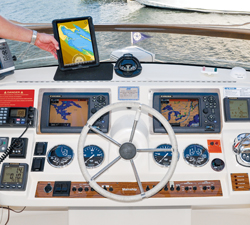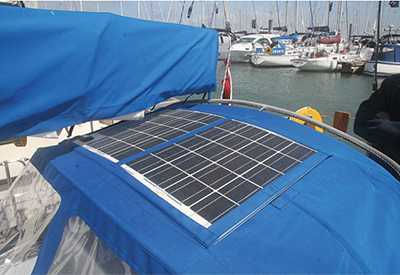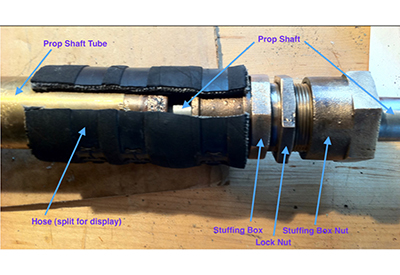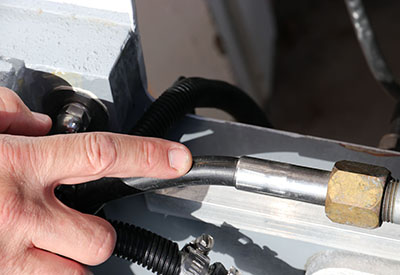User Benefits Of A Thoughtfully Equipped Helm On A 22’ Power Boat
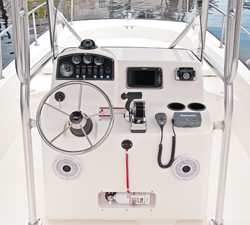

What The Latest Electronics Can Do For You!
Despite the simple appearance, this Boston-Whaler Montauk 220 has a surprisingly complete electronics suite and a host of user benefits.
In marine electronics there have been incredible advances in performance, simplicity and convenience combined with gradually dropping prices over the past few years. However, industry insiders tell us the prices have probably bottomed out; we’re not going lower.
So, if you have an older boat, now is the time to re-think the benefits you can gain by upgrading your helm electronics equipment.
If you are considering a new boat, this article should assist you in sorting out the sometimes bewildering range of capabilities and overlapping technologies.
We are taking the approach of evaluating three different helm set-ups; a 22’ power boat, a 43’ sailboat with additional equipment for club racing and finally, a 40’ trawler yacht that has been rigged out for long distance cruising.
THE JARGON
Consumers will often hear electronics jargon like NMEA 0183, NMEA 2000 and soon you will hear NMEA OneNet. Other terms include GPS, DGPS, DSC, AIS, MMSI, and of course, the great tease, Easy DIY!
Let’s define some key terms.
“Plug’n’play” means the device is supposed to just plug in and work without further adjustment or effort. Talk to your marine electronics retailer or installation technician to see that this is actually true given your existing equipment.
“Touch screen” is a screen you touch to select functions using your finger while “hybrid touch” is a touch screen that also has buttons or other controls. Some screens have just buttons for controls. The choice depends on your needs and your boat.
GPS is Global Positioning System – a global array of U.S. satellites that can triangulate to determine your position on the face of the earth within a few feet, almost anywhere.
AIS is Automatic Identification System and it uses the MMSI, Maritime Mobile Service Identity which is a unique identification code that can be issued to your vessel through our Government.
VHF radio is a Very High Frequency two-way radio for communications.
The NMEA is the National Marine Manufacturers Association, an association that works toward setting standards for marine electronics equipment, establishes technical dimensions and general cooperation through the industry to the benefit of consumers.
NMEA 0183 is the universal communications protocol for marine electronics equipment currently on the market. It uses a simple ASCII, serial communications protocol that defines how data is transmitted in a “sentence” from one ‘talker’ to one or more ‘listeners’ at a time. This makes it difficult to create a “network” but NMEA 0183 continues and is still valuable.
NMEA 2000 is a CANbus, (Controller Area Network) system that was adopted from the automotive market. NMEA 2000 allows the user to create a backbone and interconnect various marine electronic manufacturers. It is meant to be a “Plug and Play” system.
NMEA OneNet is a brand new ethernet-based version that will have far greater data speeds and capacities enabling much larger amounts of data such as video to be displayed on board. It will compliment NMEA2000 and the specifications are in draft form for publication in 2014 – a glimpse of the future!
Refitting is big business these days as boat owners discover the great capabilities of this equipment and also, how easy it is becoming to use.
Recognizing the importance of easy installation, more and more new equipment is offered with adapter hardware so the new device fits the “hole” left by the old device.
Have a look at the benefits you can enjoy with the latest marine electronics equipment!
# 1. Compass
BENEFIT: Always Know Where You Are Going
in spite of the tremendous capabilities of modern electronics for navigation, don’t forget to have a high-quality, properly adjusted compass on the helm as a way of cross checking the accuracy of your course headings. In the event of a total electronics failure, your compass could still guide you home.
#2. Paper Charts
BENEFIT: Find Your Way Home
Always have a dry, safe place to store your paper charts. They may seem old-fashioned but again, when all else fails, your paper charts can tell you where you are and can get you home.
# 3. Satellite Radio
BENEFIT: Always Get Weather Radio and More
Having satellite radio onboard is much more than just a way to blast your favorite tunes. This audio system can receive Sirius satellite radio and that in turn, broadcasts a very valuable weather information and that can display as an overlay on the chart plotter. Your audio system isn’t just for fun. Satellite signals come in from space and are available almost everywhere. Local stations broadcast across the earth and have limited range.
#4. Multifunction display
BENEFIT: Instantly Display The Information You Want
These are available from small sizes all the way up to 12 inch and larger with special superbright, daylight viewable screens that are highly weather resistant. The purpose of the multifunction display is to allow you to use same screen for all your electronics i.e. autopilot, radar, fish finder, weather overlay.
# 5. VHF Radio + ROC
BENEFIT: Emergency and Social Communications
If you have no other piece of electronics communication equipment, before you head out in any larger body of water, make sure that you have a VHF radio and what’s called a ROC (M), Restricted Operator Certificate (Maritime). The instruction course and certificate is available through the Canadian Power and Sail Squadrons – www.cps-ecp.ca. You should always monitor Channel 16 in most areas. That is where you will receive Coast Guard issued alerts to boating safety and weather alerts, communication between the Coast Guard on shore and other vessels, plus vessel to vessel communications which then move to other working channels for conversations. Of course most important of all, emergency and Mayday signals.
Written In collaboration with Andy Adams, Brian Kelly, Brad Marchant and Duart Snow

